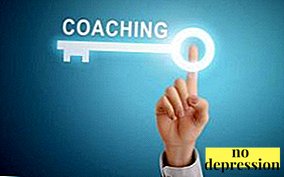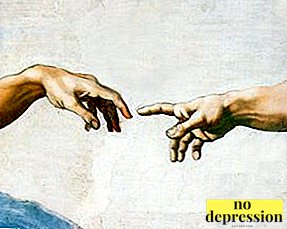To achieve success in any field you need self-discovery and the ability to manage these opportunities.
Proper resource allocation is simply called coaching. What does it mean?
The essence of the concept

What is it in psychology?
With the advent of modernity the concept of "coaching" began new era in the field of self-development.
Today, a lot of people call themselves coaches, but few can explain the essence of their work. In fact, everything is not so difficult.
Literally, the word "coach" means "cart". Such an ordinary designation of the concept came from the English slang.
Exactly "Diligence" English students called people to prepare students for classes. Today, this term has been transformed into the word “tutor,” and the concept of “coach” has acquired a deeper meaning.
Coaching is an activity aimed at facilitating training. Simple words is the science of how to effectively study, develop, achieve what you want.
The coaching process itself takes the form systematic trainingIn which students develop their skills, understand their goals and develop a phased plan for achieving them.
Conducting this seminar - coach - does not plan activities instead of the student. He only gives the tool, knowledge and motivation.
Purpose of coaching - to achieve the manifestation of a person’s internal potential to such an extent that in order to achieve the goal he will not need external motivation.
Who is a coach?

What is the meaning of this word?
As the old saying goes, the hungry need to give a fishing rod, not a fish.
So the coach gives the students only informationwhich they in turn apply depending on the goal.
The consultant does not offer ready-made keys to success. It helps to find suitable methods for each person. Gradually customer comes to understand your own potential and is looking for its use.
Answering your internal questions, the client chooses the scopein which he will apply the detected potential. This can be both a professional activity and a personal relationship.
The consultant is not a manager in the literal sense of the word. In everyday life, the teacher offers the student own knowledge base, experience and skills in order to instill in the ward certain skills.
The coach, on the contrary, does not impose his own way, but leads to the development of a personality that can solve its tasks on its own.
The difference between a coach and a coach is psychological impact method. For example, a trainer teaches work with accounting, and a coach only awakens a desire to learn something new, be it bookkeeping or another science.
Despite the clearly defined scope of impact, a competent coach helps to unlock potential and stimulates customers to develop.
Since coaching is not regulated at the level of academic science, it is rather difficult to track the quality of the services offered. A quality coach can only be called a person with certain skills.

What are the duties of a coach:
- Stimulate the client’s activities by motivating him.
- Trust in the client, the ability to see him as a responsible character.
- Search the essence of the goals to which the student aspires.
- Assisting the client in finding the most profitable growth strategy.
There is an official organization that has taken on the responsibility of training professional coaches. Throughout its history, ICF has trained more than 24,000 qualified teachers.
The International Coaching Federation trains specialists for fifty countries of the world and is the largest system in this direction.
History of
Coaching is based on the so-called “internal struggle”. The founder of this concept - Timothy Golvi. In his book "The Inner Game of Tennis," Golvi makes an assumption about a certain hidden enemy of a person who is in himself.
The enemy in his own head hinders the development of personality, creating artificial obstacles to success.

The book, published in 1974, made a real sensation.
Golvi created a whole system that helps eliminate that inner opponent.
Softening the obstacles created by himself, but not intentionally, man takes the path of development.
Later, the concept of the internal game picked up John whitmore. In 1992, he transformed the game proposed by Golvi, comparing it with the process of achieving success in business.
The founder of the first coaching system is Thomas J. Leonard, who registered the University Coaches, as well as the International Federation for the Training of Specialists.
Spheres of application
Since there are many areas for coaching, the procedure itself is divided into several types.
Individual work
Training in this case occurs without the intervention of unauthorized persons. Student and coach work face to face. In this case, special attention is paid to the environment. The process does not include not only other people, but also sounds, smells and other factors that distract attention.

Thanks to the close cooperation between the coach and the client, individual work is suitable. for business in any sphere.
Personal lessons are held in order to build a business, build personal relationships, and stimulate creative activities.
Coaching can be presented both in the form of a one-time meeting, and in the form of a number of sets.
Depending on the depth of the goal, the consultant meets with the student several times.
To solve a simple question you may need only one hour of work. To form a specific model of behavior, the coach conducts up to 8 seminars.
During system work, coaching is conducted twice a week. Often the number of sessions does not exceed 10, but it happens that global goals require longer parsing.
A type of individual training is called “co-active” coaching. In this case, the work is not built on finding a goal, but on building trust between the client and the coach.
In such a close alliance, questions come not from the student, but from the coach. And the answers to them, on the contrary, are given by the client.
The effectiveness of the method is due to "Coup" of the classic search for truth. As a rule, the seeker asks questions, and expects to hear the answers from any mentor.
Group classes

When a group of people united by a common goalit makes sense to conduct collective coaching.
In this case, the consultant works simultaneously with several clients.
Group work used in various fields.
A team can be a working team of one company, a sports team, and even a family. The only condition is a joint projectworking on the whole group.
The number of participants of such a coach unlimited. Can be involved as two people, and dozens.
Organizational view
Such coaching applies when you need to achieve a goal for a team that has leader. Work in this case is carried out both with the commander and with subordinates.
Each link receives its own assignments. The mini-goals for each participant are different, and as a result lead to joint success.
Special attention is paid to the manager in organizational coaching, because the effectiveness of an enterprise largely depends on the competent work of the first person.
Job classification
Each of the spheres of life is unique, so the work of a coach in different directions is radically different.
Classification depending on the application:
- Life. The work is based on individual training, as a result of which the student achieves balance simultaneously in various spheres of life. Both professional and personal relationships are established. Attention is also paid to creative self-expression, health and improvement of the quality of life.
- VIP. Work with a person in a management position. Development of management skills, building collective goals, personal productivity.
- Business. Work with individual departments of the company. The search for effective solutions for a specific department and the productivity of the "shop" across the company.
- Career. This type provides individual training, during which a person defines his professional goals for the near future. Most often, the coach works with one of two time periods. Plans are built for 1 year or 5-10 years.

Coaching is not only used in business and personal relationships.
Parent coaching is becoming more and more popular - the work of the parent and child as one team, designed to unlock the child's potential, talents and motivate him to victories.
Interaction techniques
There are several effective tools used in coaching. Each of them is presented in the form of techniques, gradually applied to systematic training.
Interrogative Method

Basic and mandatory interaction technique - asking questions, answering which, the student gets the keys to achieving the goals.
Varieties of questions:
- Closed. This question can be answered in monosyllables. “How old are you?” - “25”. “Do you love your job?” - “Yes.”
- Open. The client must answer this question in detail. "Tell me about your childhood", "Describe your boss."
- Clarifying. Aimed at clarifying the situation. The coach asks the question "How do I understand you ...?".
- Alternative. The questioner offers several possible answers, among which the client chooses the appropriate one. The technique is sometimes called the Chinese menu.
Scale Application
The technique by which positive changes are recorded in the state of the client. At the beginning of the meeting, the coach suggests assessing the available skills on a 10-point scale. After the training, they note how many “points” the listener's position has shifted.
For example, the client is in search of motivation. At the beginning of his work he was asked the question “How do you assess your current motivation?” The student marks five points. on the scale. The coach may also ask what the desired motivation is after the upcoming lesson.
After the occupation, the client is again offered to note his position, looking back at the acquired skills. The result will indicate whether the trainee is able to start achieving the goal now or he will need some more classes.
Other techniques
There are many techniques used in coaching. Depending on the purpose of the client, the coach selects the most appropriate methods.
Examples of effective techniques:
- Timeline. The client is offered to plan his movement towards the goal, marking the most important steps on the graphic timeline.
- Denial. The coach asks the question so that the client announces his actions in case of failure. "What if money is not enough?". "What if the project is not approved?".
- Wheel. The graphic circle is divided into sectors, the number of which corresponds to the aspects appearing in the intended goal. In each sector the “filling level” will be different, but as a result of the training, harmony will be found.
- Project. Schedule specific actions towards the desired. Step-by-step instruction created by the client during the training.

The nuances of innovation
No matter how many advantages the innovation called “coaching” has, there are some drawbacks to this method of training.
Cons of coaching:
- The need to overcome the usual resistance to innovation and innovative techniques.
- The direct dependence of the success of the project on the competence of the coach. There are very few qualified specialists on the domestic market.
- The inability of the client to concentrate on long-term projects and frequent classes. The desire to get "all at once."
Koching is a new word in the sphere of self-development. The technique allows you to achieve goals in any area, whether it is a professional idea or a desire to raise children properly.
What is coaching? Find out about this from the video:



